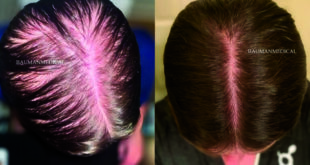By Lee R. Cohen, D.D.S., M.S., M.S. –
 Many of us have experienced the feeling of biting into something cold and feeling extreme sensitivity. I am not talking about a continued dull ache in the teeth or spontaneous tooth pain, which are usually associated with some type of nerve issue that may require a root canal evaluation. The type of sensitivity I am describing is the kind that you experience when you bite into or drink something very hot or cold. Presuming the nerve in healthy, there are a number of things that can be done to help treat sensitive teeth. The course of treatment will be based on the status of the teeth involved and the surrounding gum and bone tissue.
Many of us have experienced the feeling of biting into something cold and feeling extreme sensitivity. I am not talking about a continued dull ache in the teeth or spontaneous tooth pain, which are usually associated with some type of nerve issue that may require a root canal evaluation. The type of sensitivity I am describing is the kind that you experience when you bite into or drink something very hot or cold. Presuming the nerve in healthy, there are a number of things that can be done to help treat sensitive teeth. The course of treatment will be based on the status of the teeth involved and the surrounding gum and bone tissue.
Where Do My Teeth and Gums Stand?
In order to understand the possible cause / treatment for tooth sensitivity, let us review a few basic things regarding your mouth. Firstly, the tooth itself has two basic parts, the crown and the root. The crown is the part you can see in your mouth and is the functioning part of the tooth you chew with. Enamel covers the crown and helps shield the tooth from both cavities and temperature sensitivity. The root is the part of the tooth embedded in the bone providing support. The root is typically below the bone and is covered by gum tissue. There is no enamel on the root surface which makes it more susceptible to decay and temperature changes. If the gum and bone levels recede, more root will be exposed making cavities or sensitivity more prominent. In addition, grooves or small cracks in the teeth may allow decay and temperature sensitivity to occur more readily. All of these issues can be identified during a dental appointment.
Treatment Options
A common reason for root sensitivity is the loss of gum tissue covering the tooth due to recession. In many cases, this type of situation can be treated with root coverage procedures (also known as a gum graft). This type of procedure is usually not painful and offers the opportunity to add gum tissue over the part of the tooth that is now exposed to mouth and no longer covered by the gums. When this treatment is performed, the benefits can be numerous. The added tissue can help protect the root from future cavities and shield from temperature sensitivity. In addition, this therapy can help slow future loss of gum and bone tissue, which ultimately can help you keep your teeth longer.
In cases where grooves are present in the teeth themselves, your dentist may be able to use tooth colored filling materials or other dental restorations (such as crowns or veneers) to help cover these areas. Some situations can benefit from both root coverage tissue grafting, along with dental restorations.
There is no one solution that is good for all situations. In many cases, root coverage procedures offer multiple benefits such as decreased sensitivity, decreased loss of bone around the teeth, protection from cavities and ultimately the possibility of keeping your teeth longer. A dental and periodontal examination can help determine which treatment options are best suited for your needs.
Lee R. Cohen, D.D.S., M.S., M.S.
4520 Donald Ross Road, Suite 110
Palm Beach Gardens, FL 33418
561-691-0020
www.pbcperio.com
 South Florida Health and Wellness Magazine Health and Wellness Articles
South Florida Health and Wellness Magazine Health and Wellness Articles




